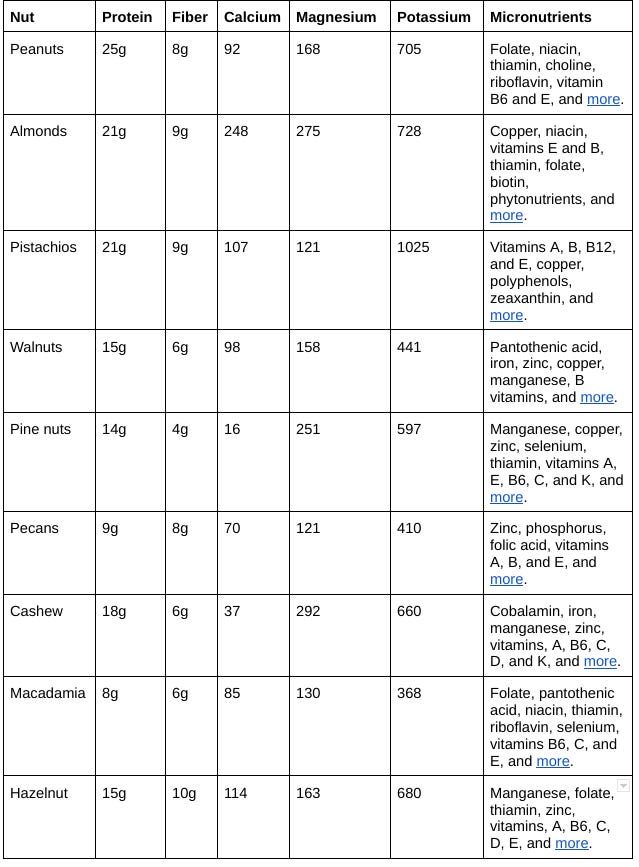NUTS
Not yours silly
Nuts have been part of the human and animal diet since the beginning of time. Like eggs, they were a staple for nutrition. Archaeologists have been able to trace their history back to the Mediterranean. Nuts were of course used for eating but also as medicine, dying, as an energy source, help with digestion, treat sores, as an aphrodisiac, and anti-intoxicater by the Greeks. They were a vital business enterprise as many cultures began to harvest, trade, and use them as gifts. Nuts played a symbolic role by representing new life, rebirth, fertility, marriage, good-luck, royalty, and magic.
Nutritional nuts:
Today, we are able to take a deeper look into the nutrition of nuts. They have been pretty well known for their ability to help reduce strokes, contain cancer fighting antioxidants, omega-3s, and lower cholesterol.
Here is a further breakdown of their nutrition according to the National Library of Medicine (per ⅔ cups):
Notice I did not add calories. That is because although nuts are typically caloric, their nutritional impact is important. They tend to help maintain a healthy weight.
Prevent heart disease
Reduce hypertension
Decrease diabetes risk
Lower cancer risk
Decrease inflammation
Reduce gallstone disease
Aid with weight lose
Lower cholesterol
Lower blood pressure
Decrease the most dangerous fat (around the organs).
Nut uses:
Cooking: Sauces, spreads, butters, soups, oils, roasting, toasting, and toppings.
Baking: Brownies, breads, cookies, cakes, fudge, muffins, and granola.
Oils: Walnut, hazelnut, and almond. Use in cooking, baking, and on skin.
Milks: Cashew, almond, walnut, and more.
Other nut uses:
Nuts have been consumed in many different ways. Today, we often snack on them raw or may add them into our baking and cooking. The Greeks and Romans used to use almonds as a “hot or dry food”. The almonds would be used to help treat illnesses, as head anointment, used on dog bite wounds, or made into a paste to help with facial blemishes. Walnuts would be used in a recipe with figs and rue leaves as an antidote to poison, also used to treat dog bites, and made into walnut milk. The leaves of the plant were used by boiling or creating a mash for both ingesting and topical use to help with ringworm, constipation relief, prevent diarrhea, and to treat sores. Hazelnuts were often used as medicines to help treat fevers and were usually toasted for consumption. Pine nuts were used to help with chest and cough conditions. They were sometimes combined with honey, grape juice, or wine to enhance their healing properties. The oil of this nut was thought to even increase semen. Pistachios had many medical uses to treat heart and lung diseases, aid with animal bites, and to help with tooth pain. It was considered an aphrodisiac. The pistachio trees were used to stop heavy bleeding and as an aid to produce hides.
More on nuts:
When finding the perfect nut either through foraging or through a grocery store, be sure to recognize signs of mold and insects. Nuts are delicious to us and many other creatures. The FDA has a great list of specific signs to notice in each nut before consumption. Depending on the nut and the storing conditions, they can last for a few months or a few years. Watch for any warning signs of a bad nut, they will be soft and smelly! There are also cases of pesticide residues being left behind on nuts.
What is the impact of nuts on the environment?
Water: A LOT of water is needed to produce most nuts, almonds being the highest at about 5 liters of water per 1 almond. California is currently the largest producer of almonds where there is also a large drought. Nuts are considered the second largest water consumer in food. Consider how much water would be needed to produce nut milk.
Labor: Nuts are often grown in other countries where forced labor exploits children and inmates. They work in poor working conditions coming into contact with hazardous materials that often leave burns and they work long hours. The land of Indigenous peoples is bought and the locals often receive low wages to work on these farms. Conflicts between governments also arise when controlling sanctions between countries.
Logistics: Most nuts are produced in other countries so trying to buy a “local nut” may be difficult if you are not in California. Nuts have to be harvested, processed, packaged, and shipped all around the world.
Labels: Look for nuts that are compliant with fair trade and organic labels.
Overall, nuts are a great snack to keep on hand. Perfect for road trips, office/purse/car snacks, and in the kitchen!
Thank you for reading!
"Destiny is Mine"
*Reminder* I am not a doctor. This is not medical advice. Please refer to your medical practitioner for details pertaining to your specific health.



